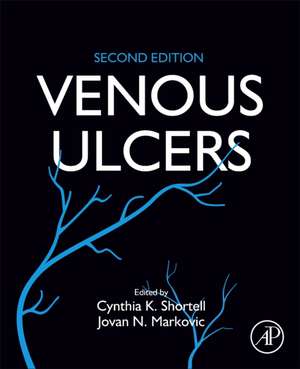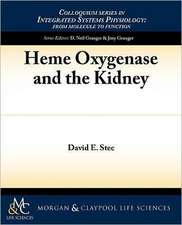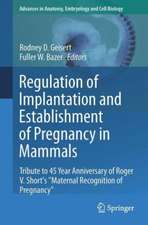Venous Ulcers
Editat de Cynthia K. Shortell, Jovan N. Markovicen Limba Engleză Paperback – 23 ian 2023
- Provides a detailed understanding of molecular mechanisms that lead to venous ulcerations that can provide a fertile environment for scientists for further discoveries
- Summarizes new findings on etiology, hemodynamics, pathophysiology, diagnosis, and treatment of patients with venous ulcers
- Discusses all currently utilized diagnostic and treatment modalities, as well as provides clear guidelines pertinent to special diagnostic considerations in a clinically applicable approach
Preț: 1071.78 lei
Preț vechi: 1338.50 lei
-20% Nou
Puncte Express: 1608
Preț estimativ în valută:
205.11€ • 222.72$ • 172.29£
205.11€ • 222.72$ • 172.29£
Carte tipărită la comandă
Livrare economică 15-29 aprilie
Livrare express 15-21 martie pentru 264.59 lei
Preluare comenzi: 021 569.72.76
Specificații
ISBN-13: 9780323906104
ISBN-10: 0323906109
Pagini: 566
Dimensiuni: 191 x 235 x 30 mm
Greutate: 1.19 kg
Ediția:2
Editura: ELSEVIER SCIENCE
ISBN-10: 0323906109
Pagini: 566
Dimensiuni: 191 x 235 x 30 mm
Greutate: 1.19 kg
Ediția:2
Editura: ELSEVIER SCIENCE
Cuprins
Section 1: Chronic venous insufficiency - basic considerations
1. Pathophysiology of chronic venous disease: genetic, molecular and biochemical mechanisms
2. Venous hemodynamics and microcirculation in chronic venous insufficiency
3. Venous ulcers of the lower extremity: etiology, risks and predictive factors
4. Venous ulcers of the lower extremity: epidemiology and socio-economic burden
Section 2: Clinical evaluation and diagnostic modalities
5. Initial clinical evaluation in patients with chronic venous insufficiency
6. Ultrasound evaluation of lower extremity chronic venous disease
7. The diagnosis of major venous outflow obstruction in chronic venous insufficiency
8. Hypercoagulable states associated with chronic venous insufficiency
9. The chronically swollen leg with ulcers - finding the cause: theory and practice
10. Lower extremity wounds associated with mixed venous and arterial insufficiency and relevant differential diagnosis
11. Assessment tools and wound documentation for patients with chronic venous insufficiency
Section 3: Non-operative management of chronic venous insufficiency and wound care
12. Compression therapy in venous leg ulcers
13. Wound healing: adjuvant therapy and treatment adherence
14. Negative pressure wound healing for venous ulcers
15. Medical therapies for chronic venous insufficiency
16. Treatment modalities for the management of nonhealing wounds in patients with chronic venous insufficiency
17. Deep vein thrombosis and prevention of postthrombotic syndrome
18. Improving treatment outcomes - management of coexisting comorbidities in patients with venous ulcers
19. Emerging modalities in local treatment of venous ulcers: advanced dressings, bioengineering, and biologics
Section 4: Operative and endovascular procedures for chronic venous insufficiency
20. Benefits of superficial venous intervention (surgery or endovenous ablation) in the treatment of venous leg ulceration
21. Superficial surgery and perforator interruption in the treatment of venous leg ulcers
22. Endovascular techniques for superficial vein ablation in treatment of venous ulcers
23. Treatment of chronic venous insufficiency with foam sclerotherapy
24. Ultrasound guidance for endovenous treatment
25. Iliac vein stenting in venous leg ulcers
26. Venous valve reconstructions in patients with severe chronic venous insufficiency
Section 5: Special considerations
27. Treatment of recalcitrant venous ulcers with free tissue transfer for limb salvage
28. Management of venous ulcers in patients with congenital vascular malformations
29. Lymphatic disorders in pathogenesis of chronic venous insufficiency
1. Pathophysiology of chronic venous disease: genetic, molecular and biochemical mechanisms
2. Venous hemodynamics and microcirculation in chronic venous insufficiency
3. Venous ulcers of the lower extremity: etiology, risks and predictive factors
4. Venous ulcers of the lower extremity: epidemiology and socio-economic burden
Section 2: Clinical evaluation and diagnostic modalities
5. Initial clinical evaluation in patients with chronic venous insufficiency
6. Ultrasound evaluation of lower extremity chronic venous disease
7. The diagnosis of major venous outflow obstruction in chronic venous insufficiency
8. Hypercoagulable states associated with chronic venous insufficiency
9. The chronically swollen leg with ulcers - finding the cause: theory and practice
10. Lower extremity wounds associated with mixed venous and arterial insufficiency and relevant differential diagnosis
11. Assessment tools and wound documentation for patients with chronic venous insufficiency
Section 3: Non-operative management of chronic venous insufficiency and wound care
12. Compression therapy in venous leg ulcers
13. Wound healing: adjuvant therapy and treatment adherence
14. Negative pressure wound healing for venous ulcers
15. Medical therapies for chronic venous insufficiency
16. Treatment modalities for the management of nonhealing wounds in patients with chronic venous insufficiency
17. Deep vein thrombosis and prevention of postthrombotic syndrome
18. Improving treatment outcomes - management of coexisting comorbidities in patients with venous ulcers
19. Emerging modalities in local treatment of venous ulcers: advanced dressings, bioengineering, and biologics
Section 4: Operative and endovascular procedures for chronic venous insufficiency
20. Benefits of superficial venous intervention (surgery or endovenous ablation) in the treatment of venous leg ulceration
21. Superficial surgery and perforator interruption in the treatment of venous leg ulcers
22. Endovascular techniques for superficial vein ablation in treatment of venous ulcers
23. Treatment of chronic venous insufficiency with foam sclerotherapy
24. Ultrasound guidance for endovenous treatment
25. Iliac vein stenting in venous leg ulcers
26. Venous valve reconstructions in patients with severe chronic venous insufficiency
Section 5: Special considerations
27. Treatment of recalcitrant venous ulcers with free tissue transfer for limb salvage
28. Management of venous ulcers in patients with congenital vascular malformations
29. Lymphatic disorders in pathogenesis of chronic venous insufficiency
























